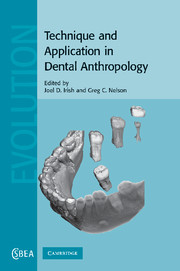Book contents
- Frontmatter
- Contents
- Contributors
- Acknowledgments
- Section I Context
- Section II Applications in assessing population health
- 4 Using perikymata to estimate the duration of growth disruptions in fossil hominin teeth: issues of methodology and interpretation
- 5 Micro spatial distributions of lead and zinc in human deciduous tooth enamel
- 6 The current state of dental decay
- 7 Dental caries prevalence by sex in prehistory: magnitude and meaning
- 8 Dental pathology prevalence and pervasiveness at Tepe Hissar: statistical utility for investigating inter-relationships between wealth, gender, and status
- Section III Applied life and population history
- Section IV Forefront of technique
- Index
- References
7 - Dental caries prevalence by sex in prehistory: magnitude and meaning
Published online by Cambridge University Press: 12 September 2009
- Frontmatter
- Contents
- Contributors
- Acknowledgments
- Section I Context
- Section II Applications in assessing population health
- 4 Using perikymata to estimate the duration of growth disruptions in fossil hominin teeth: issues of methodology and interpretation
- 5 Micro spatial distributions of lead and zinc in human deciduous tooth enamel
- 6 The current state of dental decay
- 7 Dental caries prevalence by sex in prehistory: magnitude and meaning
- 8 Dental pathology prevalence and pervasiveness at Tepe Hissar: statistical utility for investigating inter-relationships between wealth, gender, and status
- Section III Applied life and population history
- Section IV Forefront of technique
- Index
- References
Summary
Introduction
The focus of this chapter is to determine if there is a significant relationship between sex and oral disease in human prehistory. The idea that dental caries prevalence may be etiologically complex and multifactorial in nature is not new (Mandel, 1979). Nevertheless, significant advances in understanding the mechanisms of cariogenesis continue (Featherstone, 1987, 2000), and the epidemiological study of dental caries continues to broaden, embracing geographically and culturally more diverse populations. Less widely appreciated is the frequently reported finding that females display worse dental health than males, especially in epidemiological studies of living populations (Haugejorden, 1996). While some anthropologists are well aware of the tendency for women to exhibit worse dental health than men (Larsen, 1998; Walker and Hewlett, 1990), a systematic global survey of sex differences in dental pathology in prehistory has not been conducted. The present meta-analysis tested for a gender bias in oral health by gathering, critically evaluating, and statistically summarizing data on sex differences in dental caries for a global sample of early historic and prehistoric skeletal series.
A recent evaluation of the etiological role of saliva, sex hormones, and women's reproductive life histories highlighted sex differences in dental prevalence for the Guanches of Tenerife, in the Canary Islands (Lukacs and Largaespada, 2006). This meta-analysis of sex differences in caries prevalence derives directly from the first author's research in South Asia and the Canary Islands, which found that females' caries rates were consistently greater than that of males (Lukacs, 1996).
- Type
- Chapter
- Information
- Technique and Application in Dental Anthropology , pp. 136 - 177Publisher: Cambridge University PressPrint publication year: 2008
References
- 24
- Cited by



